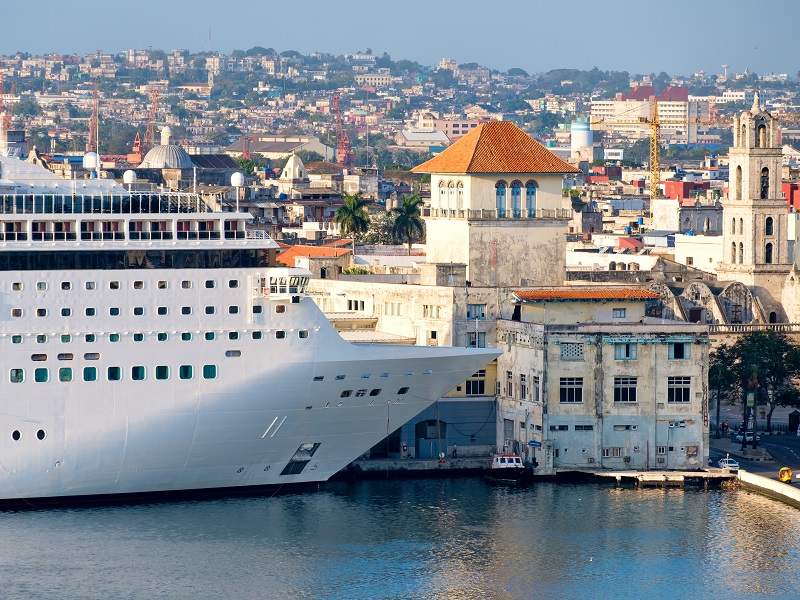
Last year, Havana’s port handled 328,000 passengers; in 2018, it is predicted that this number will reach 700,000 by the end of the year. The port currently has two cruise terminals, though with the assistance of Global Ports Holding (GPH) it plans to develop another four by 2024. The world’s largest cruise port operator, GPH will be managing the development as part of a 15-year deal that will see the company operate a cruise port in Havana. The agreement sees GPH’s total number of ports rise to 15.
While the cruise industry is huge in the Caribbean, Cuba’s ability to leverage this popularity has largely been limited by a terse relationship with the US. Prior to May 2016, the last cruise ship to enter Cuban waters sailed into Havana in 1977. Throughout 2015, the Obama administration lightened restrictions on travel to Cuba, although the general ban remained in effect. And even though the Trump administration has since tightened up these restrictions, it seems as if the cruise industry may continue to benefit under permitted travel categories.
State of the nation: where does Cuba stand for the cruise industry?
According to the travel restrictions that are placed on US citizens travelling to Cuba, there are twelve authorised categories of travel. Each of these categories is still burdened with a variety of requirements and prohibitions, which have only increased under the Trump administration. Those travelling under the people-to-people provision for example may no longer visit with just a promise to comply with US rules, but must go as part of organised groups accompanied by a guide. In addition, there is a list of hotels, stores, and other businesses tied to the Cuban military that the US government said citizens cannot do business with.
In 2017, 619,000 American travellers visited Cuba, up 18% from the previous year. In addition, it was reported by the Associated Press that the number of cruise passengers visiting Cuba increased from 184,000 in 2016 to 541,000 last year. While this number may be in some way affected by the rule changes implemented, it is likely that Cuba will continue to see rising tourist numbers, particularly from the cruise industry.
According to Hannah Sampson of Skift, a travel industry intelligence platform, “while Americans lost some of the ability to explore Cuba on their own due to restrictions put in place by the Trump administration, cruise ships are offering organized trips approved by the US government. That seems to be working out well for operators, who are eager to increase their presence in the destination.”
USA Today reported that a combination of tightening restrictions, the impact of Hurricane Irma last year, and the general perception of travel to Cuba being put forward by the Trump administration looks likely to have a cooling effect on US travel to the island. In spite of this, cruise is still booming, in no small part due to the allowance on cruise travel to Cuba being left untouched. While the Cuban travel industry may see the overall number of visitors dip, cruise still offers a viable growth opportunity, particularly when taking into account that most other visitors will not be under the same or similar restrictions as US travellers.
How well do you really know your competitors?
Access the most comprehensive Company Profiles on the market, powered by GlobalData. Save hours of research. Gain competitive edge.

Thank you!
Your download email will arrive shortly
Not ready to buy yet? Download a free sample
We are confident about the unique quality of our Company Profiles. However, we want you to make the most beneficial decision for your business, so we offer a free sample that you can download by submitting the below form
By GlobalData“The Trump administration tweaks that were made to travel to Cuba impacted the cruise industry very little,” Frank Del Rio, CEO of Norwegian Cruise Line Holdings, said during a panel discussion with other executives at the Seatrade Cruise Global event in March. “To some degree, we benefitted from that, though we didn’t need the benefit … because ships are full at good prices.”
Increasing capacity: opening up Havana
Regarding American travellers alone, the exception for cruise ship travel to Cuba has obviously played a large part in boosting tourism to the island, and has likely served to soften the image of Cuba as a whole. In April, Carnival Cruise Line announced that it was adding 20 more sailings to the country from Tampa on Carnival Paradise next year, on top of the eleven that had already been scheduled. This is in addition to the 17 cruises from Miami to Cuba, on Carnival Sensation, that were announced earlier in the year.
“Cuba has been terrific, I think, for the industry,” said Del Rio. “For our particular company, it’s been very, very good. I defined it as a home run — so much that we’re doubling capacity in 2018.”
Carnival is not alone in recognising the potential of Cuba either. Royal Caribbean added extra Cuban destinations to its itineraries and will be sending both Majesty of the Seas and Empress of the Seas on Cuban cruises. Although these come with some notable fine print – not only do they attempt to design activities in compliance with US guidelines, but they are also reliant on permission to visit from the Cuban government -any such restrictions don’t seem to be dampening the growth that Cuban cruising is seeing.
“Cruising remains the easiest way to visit Cuba, and with both Empress and Majesty sailing there in 2018 and 2019, we hope to make it that much easier for adventure seekers to experience the legendary island,” Michael Bayley, president and CEO of Royal Caribbean International, said in a statement.
With Cruise Lines International Association’s (CLIA) Travel Agent Cruise Industry Outlook Report in April showing that 43% of travel agents are seeing an increase in interest for travelling to Cuba via cruise, it seems the perfect time for a Cuban investment in the industry. Tripling the number of cruise terminals is a strong start but, while there may be a short-term dip expected for now, the continued rise of cruise travellers to the broader Caribbean region may see further expansion required both in and beyond Havana.
Caribbean market dominance: What is the future of cruise for Cuba?
The report from CLIA also showed that even though 65% of travel agents reported that the 2017 hurricanes impacted business, 86% still had clients booking cruises to the region. Cuba is still, understandably, lagging somewhat behind the rest of the region, with the World Tourism Organization figures showing the Bahamas receiving roughly five million cruise passengers annually by comparison. It should be noted that 76% of those surveyed by the CLIA reported that their clients were taking advantage of pricing discounts in the Caribbean. If Cuba can establish itself as the low-cost Caribbean destination it could grow its position in the region.
With 27.2 million passengers expected to cruise this year, up from 25.8 million in 2017, there is a massive growth market available for Cuba to take advantage of, particularly as popular destinations like Dubrovnik look to cap the number of cruise tourists visiting. There will no doubt be a struggle to compete with other destinations in the Caribbean, particularly with the restrictions and perceptions in the US, but as cruise lines and companies such as GPH make investments in the destination, it seems likely that it will draw an increasing number of passengers.
There is currently a particular market for interest in travel to Cuba, as travellers look to visit the nation before it becomes over-commercialised or political circumstances change again. With cruise lines offering convenient circumvention of any concerns travellers may have over restrictions and ensuing levels of bureaucracy, now is the moment for the industry to offer up channels for the pent up demand for the destination that may have accrued. Cuba is expected to double its number of cruise visitors this year and will triple the number of cruise terminals in the next six, so now is the time for the industry to invest in full.







